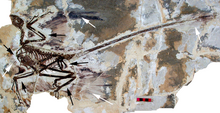Microraptoria
| Microraptorians Temporal range: Possible Late Maastrichtian record
| |
|---|---|

| |
| Fossil specimen of a Microraptor, with white arrows pointing at preserved feathers | |
| Scientific classification | |
| Domain: | Eukaryota |
| Kingdom: | Animalia |
| Phylum: | Chordata |
| Clade: | Dinosauria |
| Clade: | Saurischia |
| Clade: | Theropoda |
| Family: | †Dromaeosauridae |
| Clade: | †Microraptoria Senter et al., 2004 |
| Genera | |
| Synonyms | |
| |
Microraptoria (Greek, μίκρος, mīkros: "small"; Latin, raptor: "one who seizes") is a
Description

Microraptorians were a group of basal
Size and proportions

Most microraptorians were small dinosaurs, with taxa such as Microraptor and especially Zhongjianosaurus being among the smallest nonavian dinosaurs known. However, some microraptorians, such as Tianyuraptor and Changyuraptor, were larger and similar to other dromaeosaurids in size. Many microraptorians also had long and robust arms and legs, in contrast to the stockier eudromaeosaurs, although long arms are not universal to the group, since the basal microraptorian Tianyuraptor had unusually short arms by dromaeosaurid standards.[5] Considering this, the small size and long wings of some microraptorians likely are examples of convergent evolution with other small paravians and early birds such as Anchiornis and Archaeopteryx.
Feathers
The fossilization conditions of the Jehol group are very accommodating to the preservation of soft structures in fossils, and as a result, many microraptorians have been preserved with a covering of feathers. Not only have long, advanced feathers been preserved on the arms and tails of many specimens, but a few species even have long feathers on their legs. This condition has also been seen in other paravians such as Anchiornis, and has caused these kinds of dinosaurs to be labelled as "four-winged dinosaurs". The largest known "four-winged" dinosaur, Changyuraptor, is a microraptorian. Some microraptorians such as Microraptor possibly were able to use these wings to glide or take off from the ground.[6][2]
Characteristic features[5][7]
Microraptorines can be distinguished from other dromaeosaurids by these features:
- A maxilla laterally sculpted by small pits
- A very short manual phalanx III-2
- A shortened first digit of the hand
- A splatulate (rounded) pubic symphysis
- A metatarsal III with a pinched proximal end
- A slender metatarsal II
In addition, several features are present in microraptorines with the exception of Tianyuraptor, which is believed to be a basal member of the clade:
- A large oval fenestra in the coracoid
- Significantly shortened penultimate manual phalanges
- The posterior end of the ilium extending ventral to the ischial peduncle
- Lateral projections halfway down the pubis
- A strongly anteriorly curved pubic shaft
Classification

Microraptoria is usually classified as a clade of
The cladogram below follows a 2012 analysis by paleontologists Phil Senter, James I. Kirkland, Donald D. DeBlieux, Scott Madsen and Natalie Toth.[10]
| Dromaeosauridae |
| |||||||||||||||||||||||||||||||||||||||||||||||||||||||||||||||
See also
References
- ^ "辽西下白垩统热河群一新微型驰龙类恐龙和热河生物群驰龙类的生态位分化----中国科学院古脊椎动物与古人类研究所". Archived from the original on 2017-04-11. Retrieved 2017-04-11.
- ^ PMID 27441115..
- ^ Holtz, Thomas R. Jr. (2011) Dinosaurs: The Most Complete, Up-to-Date Encyclopedia for Dinosaur Lovers of All Ages, Winter 2010 Appendix.
- PMID 17242354.
- ^ PMID 19692406.
- PMID 25025742.
- PMID 19289829.
- ^ Senter, Phil; Barsbold, R.; Britt, Brooks B.; Burnham, David B. (2004). "Systematics and evolution of Dromaeosauridae (Dinosauria, Theropoda)". Bulletin of the Gunma Museum of Natural History. 8: 1–20.
- ^ Sereno, P. C. 2005. Stem Archosauria—TaxonSearch Archived 2009-01-15 at the Wayback Machine [version 1.0, November 7, 2005
- PMID 22615813.
- "Expand and Life history of a basal bird: morphometrics of the Early Cretaceous Confuciusornis" Luis M Chiappe, Jesús Marugán-Lobón, Shu'an Ji & Zhonghe Zhou (2008)
External links
- 1.http://www.paleodb.org/cgi-bin/bridge.pl?a=basicTaxonInfo&taxon_no=143267
- 2.http://www.taxonsearch.org/dev/taxon_edit.php?tax_id=483&Action=View
- 3.http://theropoddatabase.blogspot.com/2010/03/article-1311-means-lewisuchinaeidae-is.html
